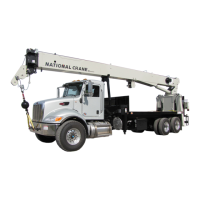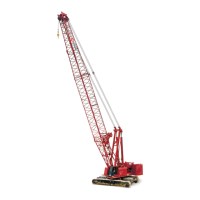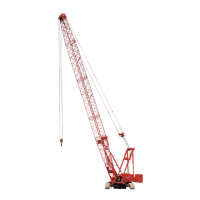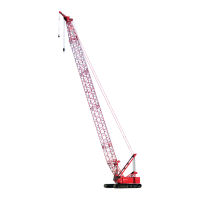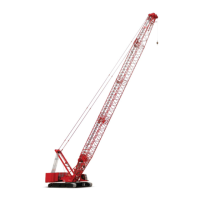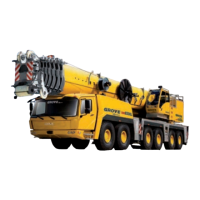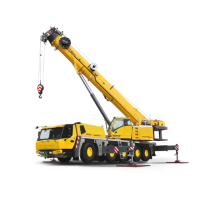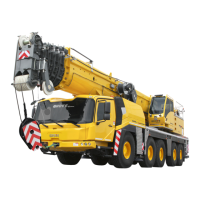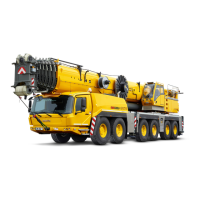Manitowoc Published 05-15-17, Control # 043-09 2-11
999 LUFFING JIB OPERATOR MANUAL SAFETY INFORMATION
o. Engage the luffing hoist pawl when operating with
the luffing jib at a fixed radius.
3. While traveling, the operator shall take the following
precautions:
a. Sound the signal horn before traveling and
intermittently while traveling, especially when
approaching personnel.
If equipped, the automatic travel alarm will sound
when the crane is traveled.
b. Carry the boom in-line with the lowerworks and
facing the direction of travel.
c. Do not position the boom so high that it could
bounce over backwards whether traveling with or
without load.
d. Secure the rotating bed against rotation except:
- When operating with a MAX-ER attachment
- When it is necessary to negotiate a turn, and
then only when the operator is seated at
controls or the boom is supported on a dolly
e. Lash or otherwise restrain unused hooks so they
cannot swing freely.
4. Before traveling with a load, the operator shall take the
following additional precautions:
a. A designated person shall be responsible for
operation. Decisions such as the necessity to
reduce crane ratings, load position, boom position,
ground support, and speed of movements must be
in accordance with the designated person’s
decision.
b. Maintain specified tire pressures (truck cranes).
c. Avoid sudden starts and stops. Use taglines or other
restraints to control the position of the load.
Multiple Load Line Operation
Multiple load line operation is becoming common practice for
applications like panel tilt-up, pile tilt-up, pile driving, rolling
fabricated sections, etc. The multiple lines may be on a
common shaft (each with different parts of line) or on multiple
shafts (lower boom point and upper point, boom point and
fixed jib point, etc).
Manitowoc authorizes multiple load line operation for those
applications requiring it, provided the following steps are
performed:
1. The qualified lift planner and the crane operator shall
read and become thoroughly familiar with the
appropriate Capacity Charts and Wire Rope
Specification Charts.
2. The lift planner and the crane operator shall make sure
the total load does not exceed the rated capacity given in
the Capacity Chart and Wire Rope Specification Chart
for given boom point or jib point, whichever is less.
EXAMPLE: If one load line is lifting from the jib point, the
proper jib chart applies.
3. The crane must be thoroughly inspected by a qualified
person prior to setup.
4. The crane must be thoroughly inspected for load line
interference caused by routing and reeving of multiple
load lines. If interference is found, it must be eliminated.
5. For cranes produced before 2003, Rated Capacity
Indicators/Limiters were not required by ASME B30.5 for
non-personnel lifting.
To aid the operator in staying within the crane's Capacity
Chart with the total applied load, Manitowoc
recommends that its cranes be equipped with Rated
Capacity Indicators/Limiters to monitor the load on each
load line.
Operator is still responsible for knowing load and
radius whether or not crane is equipped with load
indicator(s).
6. Manitowoc recommends that each load line be equipped
with an anti two-block device.
7. Manitowoc’s Capacity Charts are based on freely
suspended loads. To prevent side load damage to the
boom, the jib, and the sheaves:
• The load lines must hang as close to vertical as
possible to minimize side and forward loads.
The distance between the load points and the hook
points must be a minimum of three times the
horizontal distance between the hook point and the
load being lifted.
• The load must remain centered on the boom and jib
point shafts unless special lift approval is granted by
Manitowoc.
• The load lines should be located over the load’s
center of gravity as it is supported on a trailer, a
barge, or the ground.
8. The crane operator shall be familiar with the operational
characteristic of the crane as it relates to multiple drum
WARNING
Avoid Over Load and Side Load Damage to Crane
Manitowoc highly recommends that you contact your
Manitowoc Dealer for lift planning assistance and
approval.
